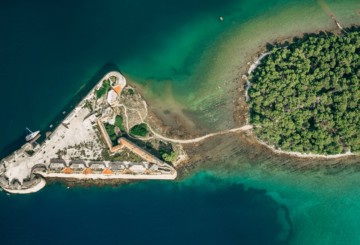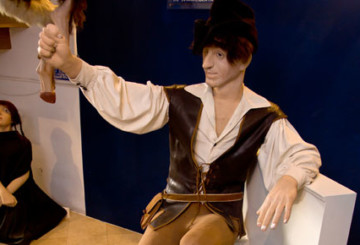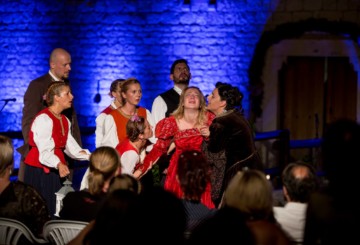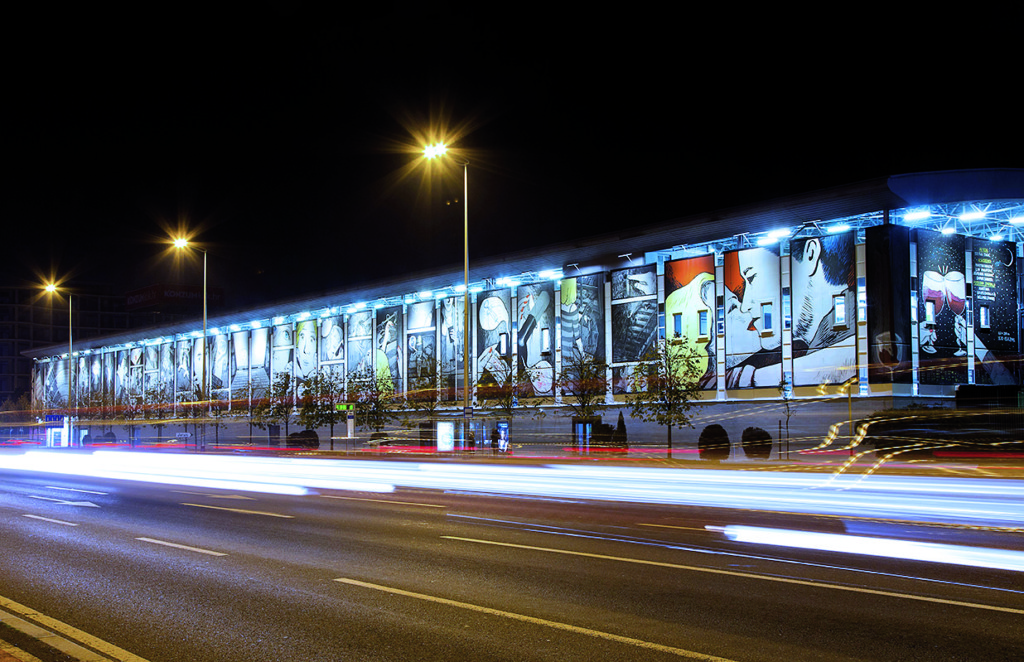
“Digital Love Story” by Stipan Tadić, Photo by Igor Nobilo for Konzum Klik
Turn a corner in Zagreb and you’re increasingly likely to come face to face with a piece of amazing street art that makes you stop and catch your breath with admiration. Transporting you for a moment out of your daily routine, it suddenly makes you think or makes you laugh.
What is street art? The first association is with graffiti. But as the artists we’ll meet here show, this is very far from the mindless, destructive scrawls many people think of when they hear the word “graffiti”. Street artists, in the true sense can create powerful images that challenge our perceptions, make us think and astonish with their sheer visual audacity.
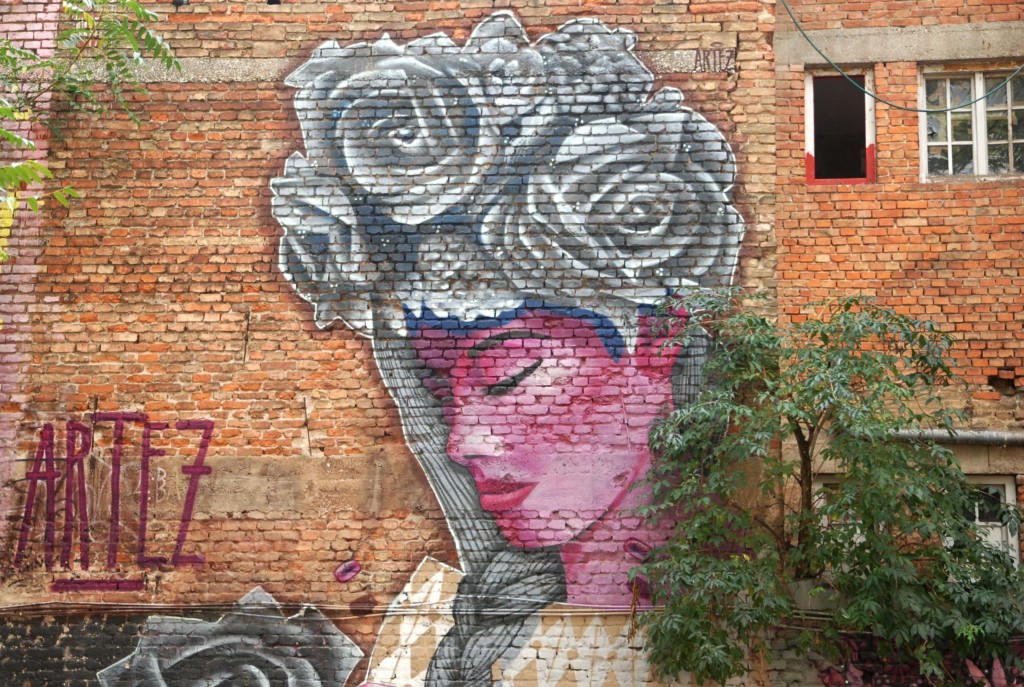
“Waiting” by Artez, Photo by Višnja Arambašić
Street artists have created a stir worldwide with provoking works that question political and social injustice. Street art is fusing with and inspiring mainstream art forms and these days work by street artists can come with a high price tag. These are artists who work in diverse media, who show in galleries and across borders, sharing ideas and collaborating on projects with artists from around the world.
Zagreb has had a street art scene since the 1980s starting with a big project for the Universiade in 1987 when the long mural alongside the railway tracks on Branimirova street was first painted. It was re-painted in 1999 to celebrate the Day Against Drug Abuse, and again in 2010 when the mural became a part of Zagreb’s Museum of Street Art, which includes works scattered around the Novi Zagreb neighbourhoods of Siget, Dugave and Utrine. The project is continuously growing to encompass and enliven other parts of the city.
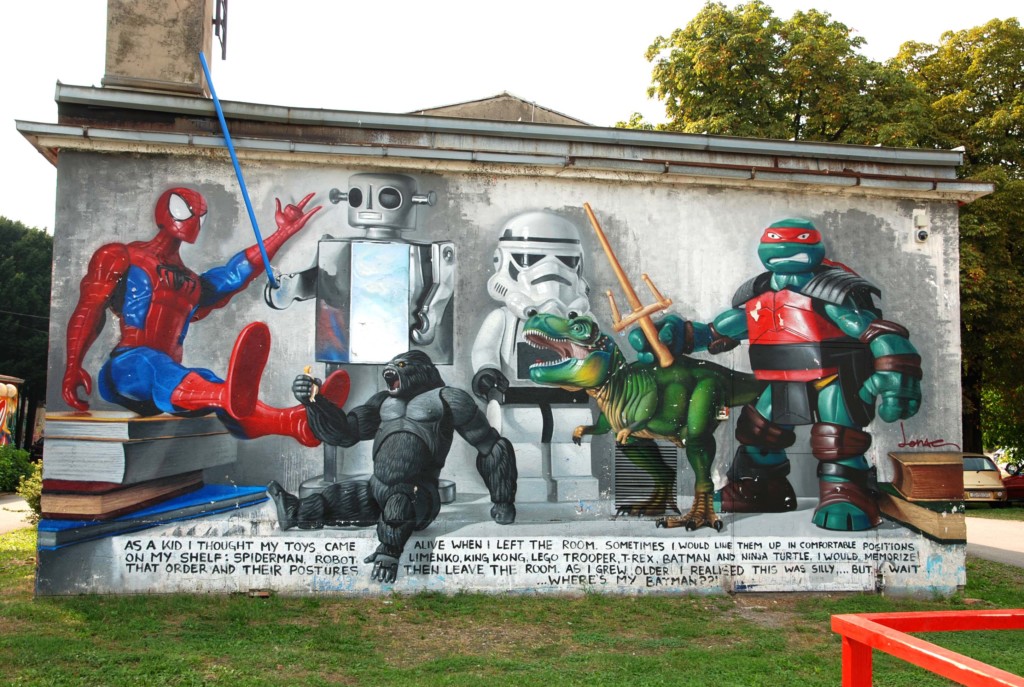
“Where is my Batman?” by Lonac, Photo by Višnja Arambašić
Excellent street art contributes to Zagreb as an exciting home for art and culture and is proof of the unique urban identity, energy and individualism of the city.
So let’s meet some of the magicians of paint and brush whom are contributing to brightening up Zagreb.
Introduce yourself! How would you define yourself? As an artist? Street artist? Something else?
Artez: My name’s Artez, I have a degree in architecture, but I’m a street artist by profession and muralist from Belgrade.
Bare: I’d define myself as someone who does what he loves, but also as an artist, street artist, organizer, etc. I like being around people and working on the street because that’s how the whole story begins and it’s accessible to everyone.
Dominik: I would present myself as an illustrator and painter; while I’m just getting into street art, I’ve worked on four murals and only one of them independently.
Modul: I began my career as a graffiti artist, then spent some time as a sign painter, then doing calligraphy, street art, it’s all there! 😀
Stipan: Hi! I’m Stipan Tadić, painter, illustrator, muralist and draughtsman from Zagreb. I finished my studies at the Academy of Fine Arts in Zagreb in 2011, and since then I’ve been working here and there as an independent artist.
Where does your tag name come from?
Artez:My name comes from the time when I was tagging walls illegally and I needed to hide my identity. That need has been lost over time but the combination of letters I found interesting from back then have remained.
Bare: I got it from my mom, hahaha!
Dominik: It’s from my mom and dad, although my grandpa wanted to call me Grga, which would have been awesome! 😀 But Stipan called me Domingo about seven years ago and so that’s what my friends call me now.
Stipan: It’s from the Dalmatian hinterland!
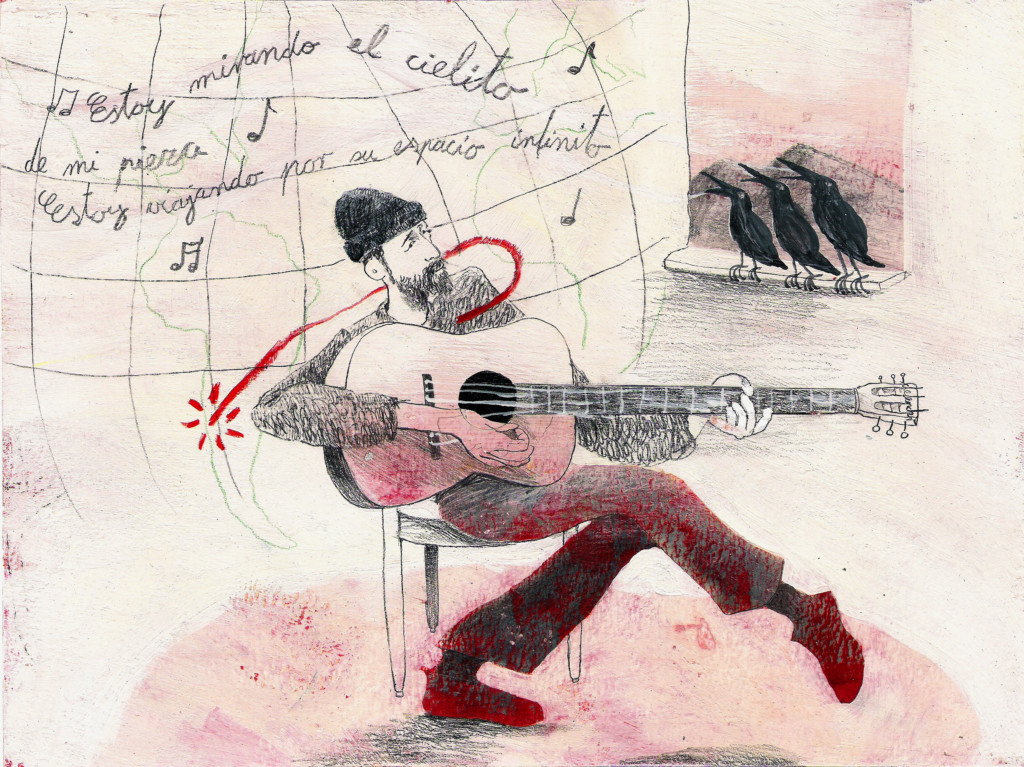
“Selfie with three crows” by Dominik Vuković
How did it all begin, and how is it today?
Artez: It all began with a passion for drawing and it’s continued to this day. I often changed my styles and fields of interest, but the love of interacting with public spaces over the years has remained. I think the biggest change in my city has been to do with the dimensions of the drawing space — the older I get, the bigger the walls get.
Bare: It started back in school writing on desks and notebooks. The first spray paint can I picked up was in the seventh grade and I started doing graffiti, and scribbling everywhere. Today I’m completely against it because I live off of my work, and I think there are other ways of expressing yourself than scribbling and destroying property. Persistence is one of the most important things for this job.
Dominik: In elementary school I realized that I wasn’t interested in school and discovered that I was going to do something creative … I even wanted to be a chef for a while! I started with tables and eventually built up some experience, techniques, ideas, and nature took its course.
Modul: When I started there wasn’t much in terms of material, and if there was it was expensive and of poor quality. So I started to mix my own water-based sprays that would be quickly washed away by the rain. Today the situation is such that everything’s available and in any colour your heart desires.
Stipan: I don’t know what you mean by “all”. But I think I started to draw around three or four years-old and I haven’t stopped. Everything has stayed mostly the same except for new techniques that I started to use, such as murals, oil on canvas…
What’s the first thing you do in the morning?
Artez: Like all millennials, the first thing I check is Instagram so I can be up to date with current events from the world of street art. The rest of the morning depends on what city I’m in and the kind of project I’m currently working on.
Bare: I have a large collection of records, so I start my morning off with music; then I do everything else.
Dominik: First I drink a glass of water; sometimes I add a spoonful of honey. Or I drink a smoothie — I like that more than breakfast.
Stipan: I make and drink kefir.
In all forms of art, inspiration is crucial. What inspires you?
Artez: I draw inspiration mostly from the location and environment in which the mural will be. Based on this, I create the composition and colour palette. The themes present on the wall very often come from the environment, but also from characters, and often emotional moments that life brings. Often what I draw on the wall is not something that I’m initially able to clearly define, but it eventually becomes clear as to why I drew it at that time.
Bare: Life stories, music, something that I have experienced, something I love, something that interests me. Since Miro and I often work together, and now that we’ve been involving Dominik, we inspire each other.
Dominik: Other people’s work has a significant impact on what I do. I like to talk about the creative process and generally about painting, illustration, or any kind of expression. For the most part, I want my work and drawings to tell a story.
Modul: Everyday life inspires me. One day you might be sad, but produce the best work possible; while another day you’re so happy you can’t even get started.
Stipan: I’m inspired by other artists — but most of all I’m driven by the fear of homelessness!
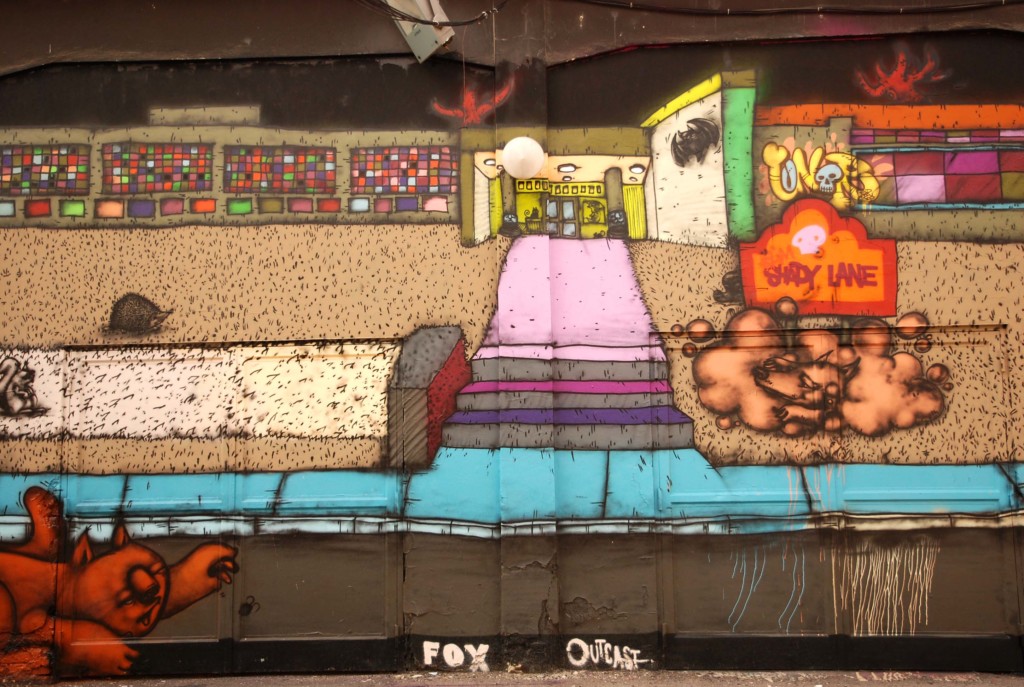
“Outcast” by Lunar, Photo by Višnja Arambašić
Tell us something about your art, does it include symbolisms, messages or repeated patterns. What’s your favourite piece of work? Artez: I try to customize my work to the environment in which it is located, and thus contribute to improving the quality of the spaces in which we live. I guess that’s a need that I developed while I studied architecture and now that would be hard to give up. My favourite piece this year is definitely the mural “What is and what will be,” that I did in Užice. Of course, the portrait of my dog Luna will always be in a class of its own!
Bare: In addition to my works on walls, I have to mention the PIMP MY PUMP project that I succeeded in introducing. It began on a neighbourhood level — then on a city-wide level — with the reconstruction of old abandoned Zagreb water pumps, which put a smile on your face with pleasant childhood memories. With this came the revival of the old park on the border of the Upper and Lower Towns, and terminated with the finial product which is the Art Park. Painting hospitals, fundraising projects and workshops, that’s all me and my art.
Dominik: I do illustrations and for now that’s my favourite work so far; my art thesis, which isn’t the best, but I did invest lots of time and effort. Even today it’s something that reminds me of the things I need to work on and how I want to develop.
Modul: Letters are my art: the art of beautifully drawn calligraphy is what I like to paint. There are no hidden symbols, they’re just stylized letters that I like to be as readable and as decorative as possible. Each piece of work is interesting, and although there are some I’m not fully satisfied with, I don’t have a favourite. The piece I do tomorrow is always my favourite! : D
Stipan: It depends on the series, the project itself, and what stage it’s in. Somehow I can’t take everything I’ve done and put it all in one basket, but yes, I use elements from all of them. My favourite piece is the mural in Dugave, ‘The Arrival of Blacks in Dugave’ because it predicted the future.
What’s the hardest part while doing a new piece of art? How do you pick a location?
Artez: The hardest part is definitely the beginning: creating the appropriate composition, choosing the colour palette and matching the theme of the mural with the environment. Once the conceptual design is complete, the creation of the piece may be physically difficult, but for me it doesn’t present much of a problem. As far as the location is concerned, I’ve lately been fortunate enough that the place chooses me and not the other way around. Otherwise, I like to draw in abandoned and dilapidated factories — walls where the ravages of time have left its mark are to me very inspiring.
Bare: The most difficult thing is negotiating the price of a commercial piece of work. And in terms of the work itself, the hard part is setting up and the preparation until the actual fun part begins. While walking through the city I don’t look down or at my cell phone, I study everything around me (the buildings and walls) and when I see something abandoned, decrepit — like the former Art Park —I get ideas about what I could do.
Dominik: I think it’s the same like in all forms of art, and that’s coming up with a viable idea. The sketch, format, medium and technique are all steps that come later and tie together with the idea. The location is anywhere my friends call me to. 😀
Modul: The hardest part is setting it all up and paining the wall with the background colour. Everything after that is fun! The wall simply catches my eye. And if it’s a special location I try to get in contact with the owners and get permission to carry out my idea.
Stipan: The problem is that I’m not exclusively a street artist; therefore the walls choose me — and not the other way around. I simply get invited by organizers to take part in festivals where I’m presented with a wall. But now, for the first time I want to start choosing my own walls, so I think I’ll have to start doing that soon.
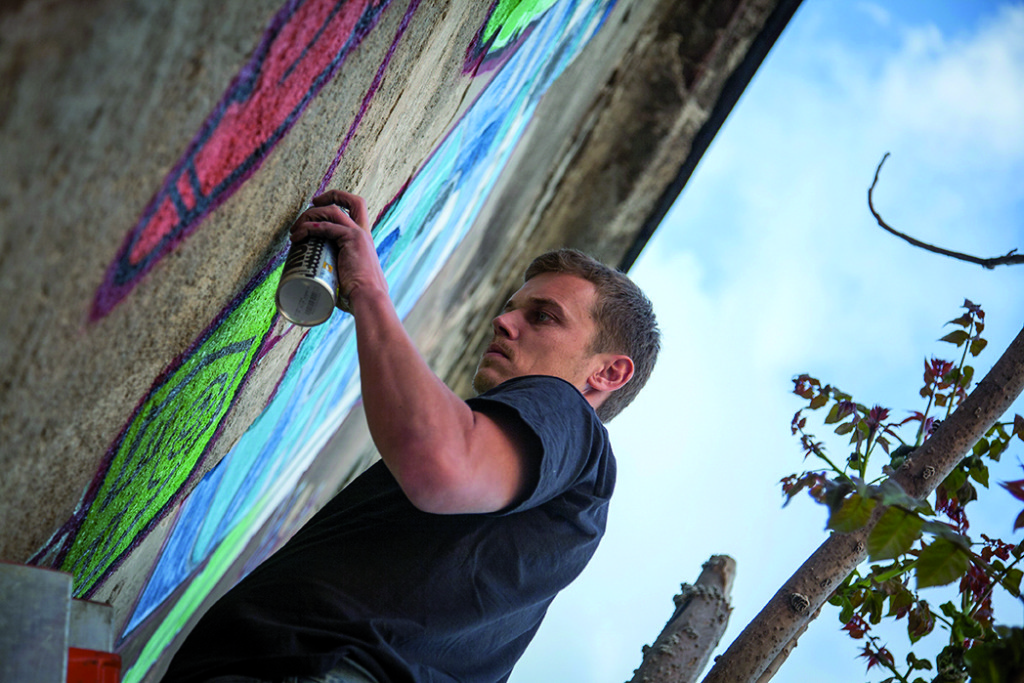
Boris Bare at work, PIMP MY PUMP Archives
Street Art is a visually stimulating form of art. If you could add another element, what music would you pick to accompany your work?
Artez: Right now it would be one of David August’s mixes.
Bare: Pink Floyd.
Dominik: Of all the musical genres, I somehow always come back to Blues — which for me is particularly endearing: it’s simple and very narrative; it tells a story that inspires me. I really like the period between the 50’s and 70’s, especially Little Walter for his harmonica (which I also play) and Lightnin‘ Hopkins.
Modul: Music is always necessary when I work and I love Rock the most.
Stipan: I’ve never thought about that. But maybe it’d be classical music from the Impressionist period.
Which cities inspire you the most?
Artez: Cities for me have become very boring, so I rarely get inspiration from them. I’d say I get more inspiration from the people I meet during my travels, whether that be in cities or not. Definitely my biggest inspiration is nature: plants, and the colours that appear in the sky during sunrise and sunset.
Bare: Mostly Zagreb. But I like to travel, so every year I try to go on a journey somewhere to expand my horizons a bit and along the way I get some inspiration.
Dominik: I’ve never sought inspiration from the city itself, but more through friends in Zagreb. I associate romance with cities like New York, Berlin…
Modul: Of course, Zagreb! I’m glad that Zagreb has a lot of artists now. We’re very diverse and everyone has their own style with lots of room to develop. There aren’t imitators who want to be like someone else, each artist is an individual with their own space.
Stipan: Berlin, Moscow, Paris.
What’s the first thing that comes into people’s minds when they see your work on the streets?
Artez: Haha, I can’t speak for everyone, but I’m sure some of them say, ‘Look! It’s that fern-man again!’, probably because of the floral motifs which I’ve recently been incorporating in my work.
Bare: For now I’ve had more positive reactions than negative ones because of my work on abandoned buildings, so the final result is something that immediately cheers people up. I’m more disappointed myself with some of my work because I think I can do a lot better.
Dominik: Well, I don’t see them much, hahaha. I did a solo piece called ‘The Birds of Zagreb’, and I don’t know what people think when they see it. But while I was doing it they’d show interest as they walked by — which I thought was cool.
Modul: I most often get positive comments, like: ‘Wow, that’s nice!’ or ‘Awesome! The wall was terrible, now it’s finally beautiful.’ Realistically, the people who would complain have nothing to say because you’re doing something positive for the community — regardless of the fact that you’re promoting yourself — the final product is for everyone.
Stipan: I’d love it if it made them smile, but I don’t know to what extent I achieve that.
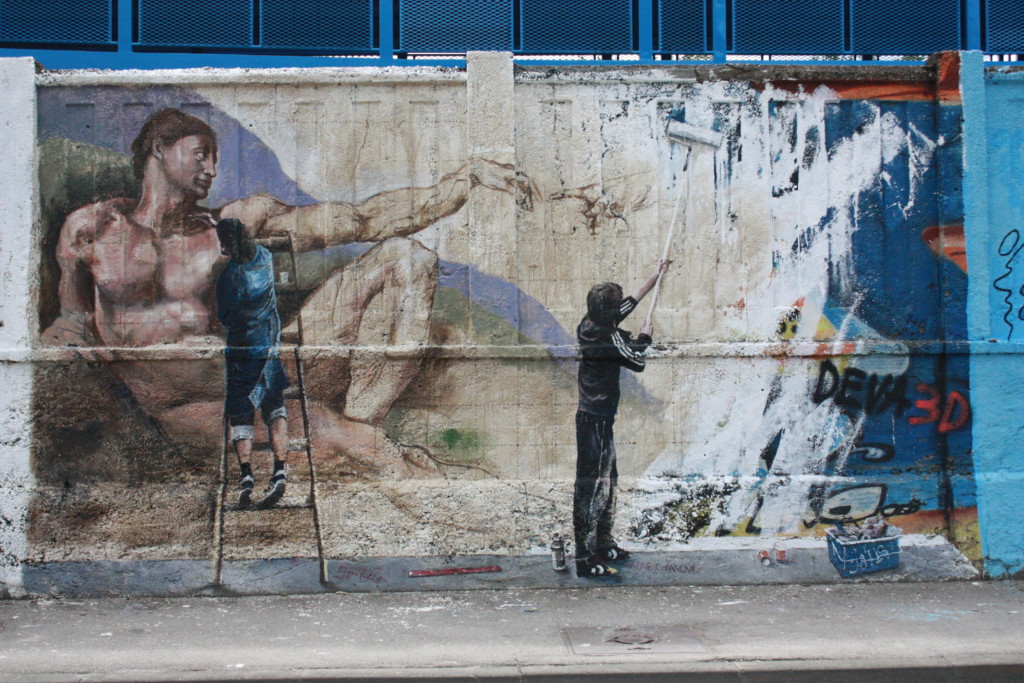
“Making the Creation of Adam” by Stipan Tadić
How long do your works last on the street? How do you react when you see that someone has defaced your work (if that happens)?
Artez: It all depends on the particular location — there really is no rule. I came to the realization a long time ago that street art isn’t a permanent thing, so I don’t have a problem when other people manipulate my work. Once the work is done it stops belonging to me and belongs to everyone; so if someone wishes to ruin it they have just as much right to do so as I did in drawing it.
Bare: There are lost of pieces that have remained untouched to this day — in Trešnjevka there’s a piece in a park on Adžijina St. that’s not been untouched in 3-4 — and there’s no problem if someone draws something beside it. The situation like the one on Branimir pains me a bit where a mural that takes 2-3 days to do gets spray-painted on and disfigured in a few seconds. But when you’re doing work on the street you know that it’s not forever and will eventually fade away.
Dominik: It’s still there 😀
Modul: Some are still around today after years and years, and some survive half an hour because there are vandals and of all the walls in the city they choose yours as the one to mark up. When I finish a work I take a photo for my album, if it happens to be late I come back the next morning and after that whatever happens, happens. We had a situation in Mostar where overnight they tagged over our freshly completed wall which we had to fix up the next morning; of course, later the guys felt bad and apologized. When you work on the street you have to expect things like that.
Stipan: I’d be upset, but of the 5-6 years I’ve been doing murals most of my work has survived.
Are there artists whom you admire, and why?
Artez: I admire musicians most of all because for me it’s incomprehensible that someone can trap energy as sound. Music influences my mood and the inspiration I get from it is reason enough to believe that some musicians are from another planet.
Bare: There are many of them who do great things but I don’t know who I’d specifically like to mention.
Dominik: I’ve got so many I can’t count, but it changes depending on my momentary interests and needs. I look at them as mentors I can learn something from. From some of them it may only be a word about technique that I hadn’t thought about before but which I can now notice in my work.
Modul: Each artist has his own artist. I’ve been inspired by Salvador Dali since childhood. As for street art artists there are a million and I follow all of them on social networks and so I’m up to date with their work which I think’s great.
Stipan: Of course, I always admire relaxedness, versatility, directness, unpretentiousness, sense of space, emotion and composition, and performance skills.
What other passions do you have besides for art?
Artez: I love to travel, cook and eat; so if I get to blend all three together and spice it up with drawing, my happiness would know no bounds.
Bare: Traveling and snowboarding. Basically I like to be outside in nature as much as possible.
Dominik: I like biking the most, but also sports and physical activity in general. Like how books are for the soul, sports feed the body.
Modul: I was a pro Skateboarder, and I generally love all sports. Besides football, I like to fish, ping pong is fun, I like to play card games like Bela, I like everything that young people like: D
Stipan: My biggest hobby is biking.
Where do you see the whole street art movement in ten, twenty years?
Artez: Computers— I think with the development of technology will come new tools that will allow artists to create huge works art from the comfort of their own homes (or maybe from armchairs placed in front of the wall). Some pioneering attempts using drones to draw on walls have already been made. And there are already rumours regarding the development of large printers that will be able to “print” murals on buildings. Of course, artists who make street art using traditional methods will always be around, but the development of new technology will definitely affect their lives.
Bare: Somehow I feel like it’s at its peak. There’s a hype surrounding street art now, but I have no idea how things will continue to develop. It’s great to see that finally people and institutions have begun to accept the street art movement.
Dominik: On a higher level, of course, street art and murals have been around for a long time but I think that it’s still in its infancy, and in my opinion for development there needs to be more planning.
Stipan: It will go into manirism and collapse; at best, the last jolt will produce something new + of course the “old-schoolers” will continue to do graffiti.
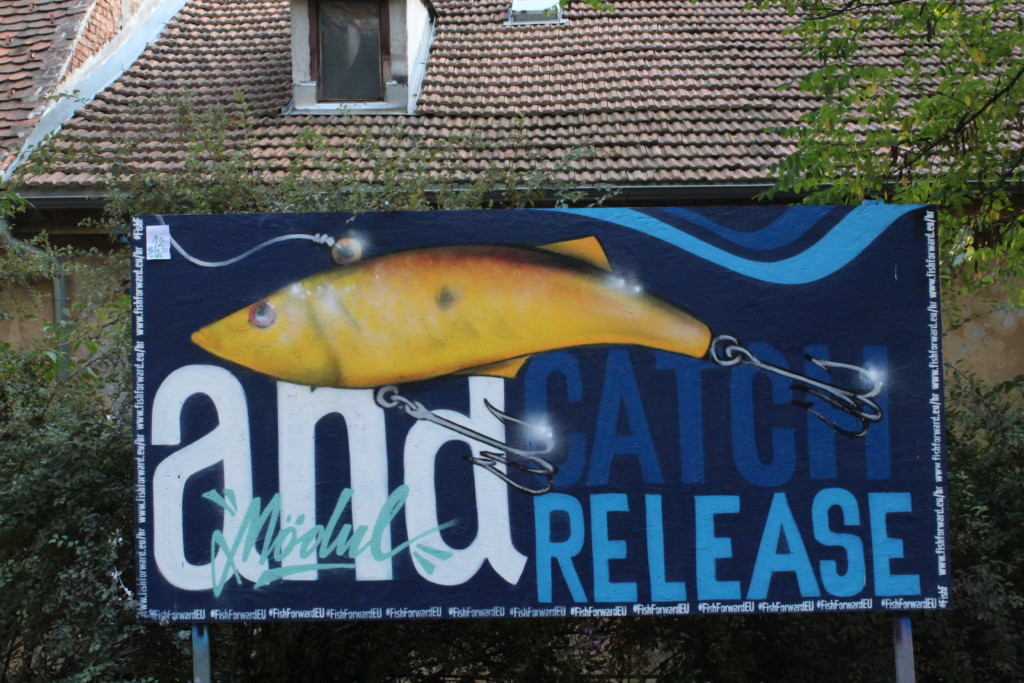
“Catch & Release” by Modul, Photo by Marša Gajinov
As an artist, do you feel any responsibility towards society?
Artez: I feel an obligation to remain true to the craft that I have chosen and to keep things on the streets as much as I can, so that in this way I can lead by example and prove that it’s possible live off one’s art. I also think it’s very important that your actions send a positive example, not only on a professional level, but also on all other levels. Something like Miss World, only with a little more paint on the fingers and clothes, haha.
Bare: I do, that’s why I try to contribute to community projects like Art Park, educational workshops, and fundraising events, in order to send a particular message.
Dominik: Yes, if you have the opportunity to put something in front of people, you definitely need to choose your words and the way you present things. I especially like the idea that we are all teachers and students and that we can influence someone or something.
Modul: Of course. All works on the street are part of a conversation with the people, so that’s why I always try to make sure it’s positive.
Stipan: Sure, every piece of work has to communicate with and educate the viewer.
Is there a specific thought or message you’d like to pass to the readers?
Artez: Be consistent in your work and never give up on what you love!
Dominik: Be teachers…and students… hahaha.
Modul: Catch and release.
Stipan: Drugs don’t expand your mind.
In your opinion, where’s the best place in Zagreb to relax?
Artez: Art Park, because that’s where my friends are!
Bare: Art Park, but during the winter it’s Atelier Lapo Lapo and of course Sljeme.
Dominik: Art Park and any other park when the weather’s nice. I like to drink tea/beer/wine in Mali Medo on Opatovina St.,and I like to hang out in Atelier Lapo Lapo.
Modul: Art Park, Gradec, vidikovac, Strossmayerove stube, Zrinjevac, basically wherever there’s green space. During the summer it’s mostly along the Sava river while fishing under the bridge and enjoying the shade.
Stipan: Sljeme.
What’s the best way to get to know the city and its people?
Artez: Through drawing, of course!
Bare: Infiltrate yourself among like-minded people and explore the city with them.
Dominik: Through conversation! That’s the best and most natural way.
Modul: Drawing and conversations: that’s how many new projects and friendships have come about.
Stipan: I somehow always met the best people in the strangest places, but again, Krivi Put is a nice place to start.
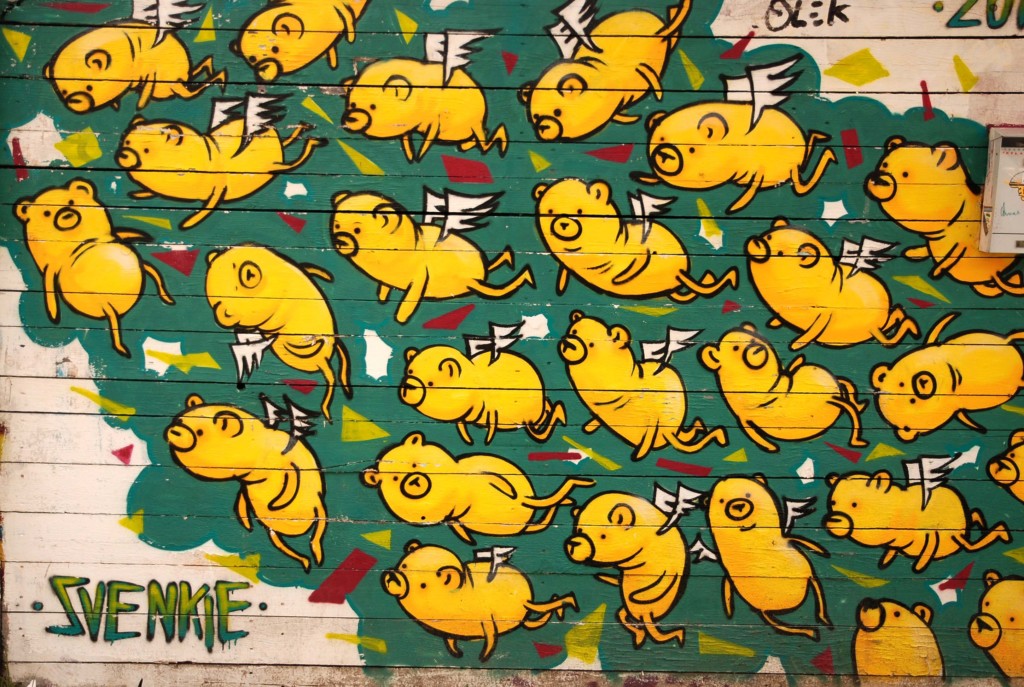
“Bears” by SVENKIE, Photo by Višnja Arambašić
Where do you think’s the best new place for street art in Zagreb?
Bare: The sides of buildings that are in bad shape which are all over the city.
Dominik: Neighbourhoods! Neighbourhoods are great: Novi Zagreb and Trnje have many grey and depressing socialist buildings which could be brought to life with murals.
Modul: I think the only legal place remaining is the roundabout, which is also the worst possible place. A lot of the facades have begun to be painted, so I think that most of the potential walls are in the centre and are yet to be discovered. And the people themselves will start to seek out the artists, just like we were contacted by the tenants of a building who were interested in their facade being painted.
Stipan: I think the whole city has potential for street art, especially Novi Zagreb.
How has street art changed in Zagreb and Croatia in the last few years?
Bare: Like I’ve already said, I think we’re experiencing a lot of hype, and that fact’s proven by how much work we have.
Dominik: It’s growing and developing well, but there can still be more.
Modul: It’s changed immensely. Until about 5 years ago there weren’t so many people — mainly graffiti artists — while now there are people doing murals, stencils, stickers, posters and looking for any piece of wall, entranceways, and door where they can leave their mark. There was a boom and a lot of new names came out of it, which if it continues like this will be great for street art.
Stipan: It’s strange here, street art had a roof over its head before it really came to life on the street. Interestingly it’s held together by a total of about 5 people. At first, the only serious “street artist” — except for graffiti artists — was Filjio, who did a pretty good job of keeping his anonymity; which I think is cool with “real” street artists. Right now Lonac is very active and very good + graffiti artists Chez and ManeMei…
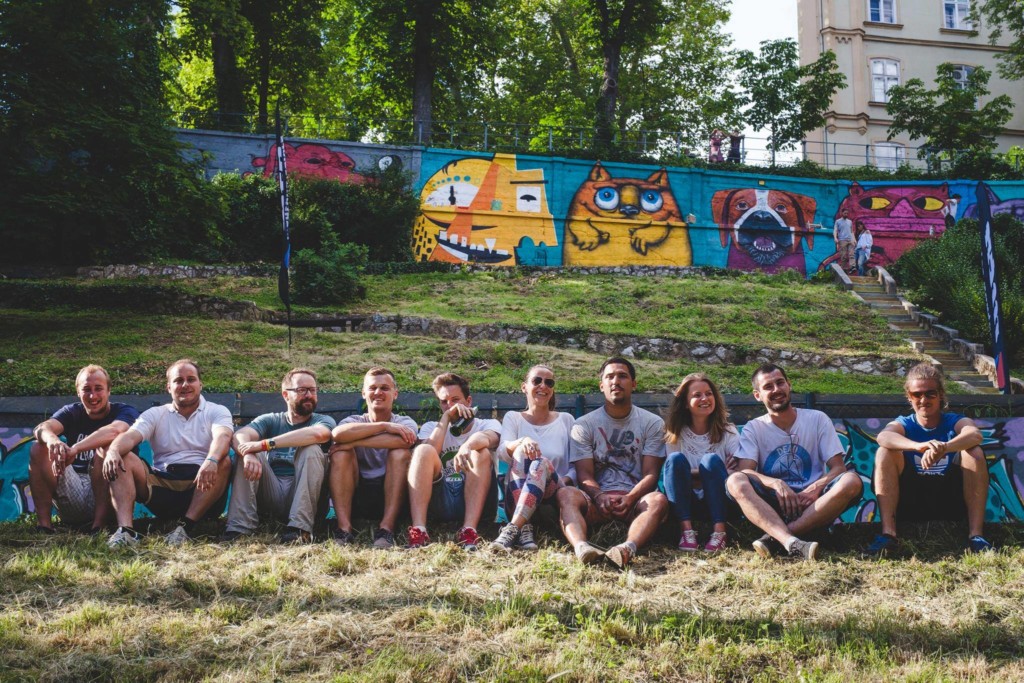
Art Park, Photo by Silvio Lončarić
